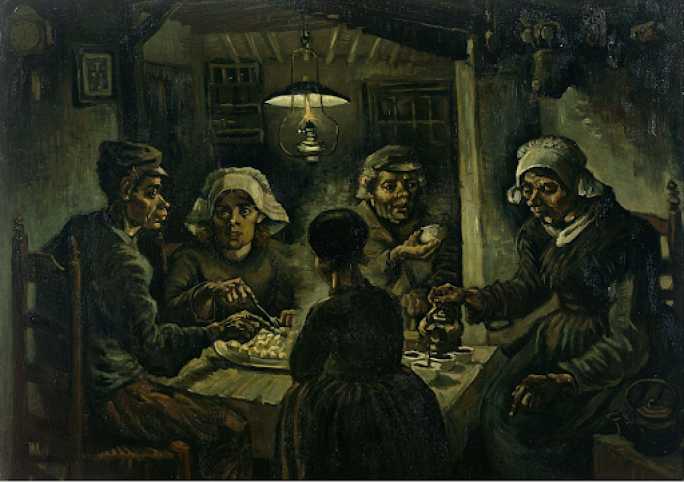Executed in 1883 when Van Gogh was living in The Hague, Hoofd van een visser, driekwart naar recht is one of a series of the artist’s depictions of fishermen, for whom he developed a particular affinity. “Heads of fishermen, old and young, that’s what I have been thinking of for a long time,” he wrote to his brother Theo in late 1882. (quoted in The Van Gogh Museum, ed., Vincent Van Gogh Drawings, vol. I, New York 1990, p. 197). The present work is thought to be a precursor to a group of fishermen’s portraits, four of which are held in the Van Gogh Museum in Amsterdam (see figs.1-4). Influenced by the social realism of Courbet and Millet, Van Gogh turned to representing the working classes during his time in the Hague. Many of these early drawings culminated in one of his first recognized masterpieces, The Potato Eaters, also in the Van Gogh Museum (see fig. 2).

Fig. 1 Vincent van Gogh, Head of a fishermen with a sou’wester, 1883, Van Gogh Museum, Amsterdam.
Fig.2 Vincent van Gogh, Head of fisherman with a fringe of beard and sou’wester, c. 1882-1883, Van Gogh Museum, Amsterdam
Fig 3. Vincent van Gogh, Head of a fishermen with a sou’wester, 1883, Van Gogh Museum, Amsterdam.
Fig. 4 Vincent van Gogh, Fisherman with sou’wester, pipe, and coal-pan, 1883, Van Gogh Museum, Amsterdam
“The fishermen know that the sea is dangerous and the storm terrible, but they have never found these dangers sufficient reason for remaining ashore,” the artist once wrote. The present work seems to encapsulate the sentiment of his observation. Depicted in three-quarter profile, the figure gazes intensely into the distance, the creases of his face and downturned eyes suggesting the weariness he has endured as a result of his trade. Van Gogh’s expressive draftsmanship is on display here, with thick, bold lines that convey the individuality of this figure and prefigure the brushwork of his later masterpieces.
Hoofd van een visser, driekwart naar recht was executed in both pencil and lithographic crayon, a combination Van Gogh experimented with beginning in December of 1882. Influenced by engravings illustrated in London magazines, the artist was particularly attracted to the deep black that the lithographic crayon produced. Writing to Theo in 1882, Van Gogh describes his process behind these drawings: “So I finished my drawings pretty well in pencil, indeed as much as possible. Then I fixed them and dulled them with milk. And then I worked them up again with lithographic crayon where the deepest tones were, retouched them here and there with a brush or pen, with lamp-black, and worked in the lighter parts with white body-color.” (quoted in The Van Gogh Museum, ibid., p.197). This careful process is extraordinarily exhibited in this drawing. The darker, thicker lines of the lithographic crayon are visible in the shadings of the fisherman’s hat and around his face, contributing to the rich interplay of values that Van Gogh achieves without using color.
